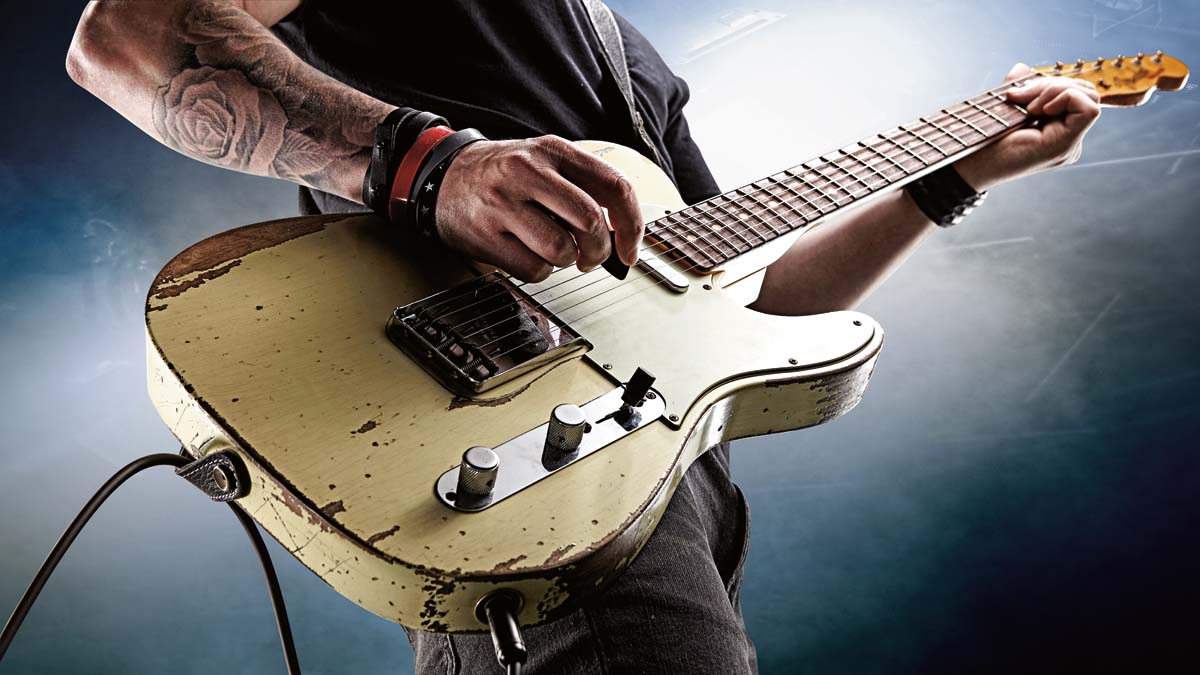Learn 20 essential rock rhythm guitar styles
From grunge and metal power riffing to cowboy chord arpeggios, open G folk and math-rock fingerpicking

The conventional idea of what makes a ‘great’ player is often centred around the expectation of blazing solos and electric guitar pyrotechnics. Of course, experienced guitarists know there’s more to it than that.
Think of your favourite players. Whoever they are, even if they’re better known for blistering solos, we’d lay odds that they have razor-sharp rhythm guitar skills to match. When it comes to rock music, rhythm playing is a particularly broad church.
It’s not enough to just be a competent strummer. You could be tackling single-note pentatonics, chords and arpeggios of all flavours, countless altered and drop tunings, and rhythms ranging from straight eighths to syncopated math-rock in whacky time signatures.
Like we say, there’s a lot of ground for the well-rounded guitarist to cover. Here, we’re taking a look at the styles of some of greatest guitarists of the last 50 or so years.
There’s plenty to learn from each example – you’ll learn how individual players have approached rhythm guitar and you’ll also pick up some broader genre-based tips along the way. We’ll kick off with a look at a well-used altered tuning...
1. Open G Blues Rocker

Open G tuning (DGDGBD) is used by everyone from the Rolling Stones to the Black Crowes. The open-strings major chord is great for slide and for first-finger barre chords.
Adding your second and third fingers into the mix allows for some great riffs that would be otherwise impossible in standard tuning.
2. Hazy Blues Riff

Classic Hendrix meets modern blues-rockers, Josh Smith, Philip Sayce and Orianthi here in a syncopated blues riff. The D7#9, though not the full Hendrix shape, is a classic chord that sounds great with overdrive. Combined with simple lead phrases, it extends the sound of the G blues scale without sounding like lead guitar.
3. DADGAD Rocker

Although Jimmy Page helped put alternate tunings on the rock map, our DADGAD-tuned riff is more about helping you to visualise the fretboard a little differently.
Because all the fingerings you’re used to sound different, you can create new ideas just by using your ears and letting your fingers run wild.
4. Punky Barre Chords

The one-semitone ‘approach from below’ riff in bar 1 is pure punk-rock fare a la Ramones, Sex Pistols, the Clash and so on. The barre chords in bar 2 are more broadly suitable for punk and garage rock – everything from Joan Jett to The Hives. Down-pick in bar 1, then switch to looser strumming in bar 2.
5. Pop-Punk Powerchords

In the 90s and 00s, acts like Green Day, Sum 41 and Blink-182 brought old-school punk up to date with high-gain tones, polished production and a new slacker/skater vibe.
Feel-good chord sequences like the I-V-VI-IV-V (G-D-Em-C-D) in bars 3 and 4 differentiates their output from the more po-faced early punk.
6. Aussie Rock Chords

We’re unashamedly in the style of the late AC/DC rhythm legend Malcolm Young here, though acts like The Darkness and Greta Van Fleet are also in our sights.
The essential riffing elements are offbeat chord changes, a mix of palm-muted and un-muted notes and the two-chord turnaround at the end. Instant ’DC!
7. Purple Ostinato Riff

Think of players like Ritchie Blackmore, Lita Ford and K.K. Downing and you’ll likely come to an ostinato riff like this.
The trick is to wrap your thumb around the neck to fret the low G note without interfering with the fretting of the other chords. Aim for some juicy vibrato on the last diad, using your third and fourth fingers for maximum wiggle.
8. Blizzard of 16ths

Ozzy’s guitarists (think Randy Rhoads, Jake E. Lee, Zakk Wylde) have recorded countless examples of this type of riff. The rapid-fire 16th notes that underpin the chords need steady palm-muting to keep things tidy but the two- and three-note shapes should ring out cleanly.
9. Two-Guitar Gallop

Bands like Iron Maiden and Heart may have pioneered this galloping rhythm and harmony in 3rds, but modern players like Nita Strauss love the high energy and technical precision, too.
We’ve shown the high harmony notes in our riff as a separate part for a second guitar in red here. Try both parts out!
10. Hairy Metal Legato Riffing

80s shredders such as Eddie Van Halen, Steve Vai, Jennifer Batten and Paul Gilbert loved this super-fast swing style. The secret is to focus on your alternate picking.
Keep it strict throughout, so when you execute a pull-off you’re still making a picking motion. The timing is a challenge at this speed, so slow down while you practise.
11. Cowboy Arpeggios

These are typical sus2 and add9 ‘campfire chords’. Think of bands like Poison and Guns N' Roses and you’ll get the idea. Hammer-ons and pull-offs extend the sound of the basic chords – again, typical stuff.
Aim for a ‘pick in the direction of the next note’ approach and try to keep your pick hand movements as efficient and clean as possible.
12. Powerchord Illusions

Splitting two guitars into separate parts of the powerchord is a great idea that has been favoured by Slash and Mick Mars amongst others.
The idea is to use an ‘inverted powerchord’ – just ditch the bottom root note of each chord. The second guitar can then play this as a single-note riff, with a lot more freedom to expand on the basics.
13. Mute-Tallica

Metallica, Megadeth and Slayer were the biggest exponents of this style of thrash metal during the 80s and early 90s.
The palm-muted open sixth-string root notes are essential, and the powerchords, including the F5 one fret above the root, are typical fare. Keep your pick hand close to the strings and aim for small, efficient movements.
14. Southern Metal Syncopation

The late, great Dimebag Darrell was famed for his syncopated, brutal riffs. Developing the 80s thrash theme, but at a slower tempo allows for more rhythmic complexity and Dime’s trademark sense of groove.
Use alternate picking throughout (you’ll hit a lot of upstrokes here!) and use your fret hand to keep the idle strings muted.
15. Korn Bizkits

The late-90s seven-string explosion was dominated by Limp Bizkit’s Wes Borland and Korn’s Munky and Head. If you want that sound, you’ve gotta tune low!
Borland favours B F# B E G# C# C#; the Korn pair go as low as ADGCFAD. Try tuning a six-string guitar set to the lowest notes of these tunings; we’ve opted for BEADGBE here.
16. Maths Homework

Math-metal is characterised by complex rhythms. Think of our Meshuggah-inspired riff as a variation on 4/4 time, with an extra eighth note added to beat 4.
It’s tricky to get the feel, so count ‘1 & 2 & 3 & 4 & a’ to keep time. Practise by playing each ‘beamed’ group of notes on its own before jamming with our audio track.
17. Emo-tive Chords

Whilst drop-D tuning adds heaviness and some easy first-finger barre chord shapes, it can also inspire sweeter sounds. Think early-00s emo and post-grunge and you’ll get what we’re driving at.
It also shows that hard rock doesn’t have to be in angsty minor keys. A mix of major, minor and sus chords sounds fresh here in our riff.
18. Grungey Fives

This riff is inspired by Jeff Buckley, Radiohead, even Soundgarden – acts that employ a left-field songwriting approach, using odd time, complex chords and non-standard tunings.
Here, everything is based around an open D drone, but the key isn’t set in stone. The chords move in and out of different modes, giving a slightly psychedelic vibe.
19. Golden Rules

We’re taking inspiration from Biffy Clyro and Royal Blood here as we exploit the clarity of single-string riffs and octaves rather than ‘denser’ powerchords.
The octaves can be as melodic as you like, so experiment by moving them around the fretboard. The 16th notes in bar 2 are all about consistency, so use steady alternate picking.
20. Prog and Math-Rock

Plini and Yvette Young often shun the distorted tones of traditional shred, delivering complex rhythm work that takes up where math metal leaves off.
Rich fingerpicked chords with melodic lines and Satriani-esque tapping are essentials. Get to grips with the (relative!) basics in bar 1, with a capo’d chord groove followed by tapping in bar 2.
Get The Pick Newsletter
All the latest guitar news, interviews, lessons, reviews, deals and more, direct to your inbox!
Total Guitar is one of Europe's biggest guitar magazines. With lessons to suit players of all levels, TG's world-class tuition is friendly, accessible and jargon-free, whether you want to brush up on your technique or improve your music theory knowledge. We also talk to the biggest names in the world of guitar – from interviews with all-time greats like Brian May and Eddie Van Halen to our behind the scenes Rig Tour features, we get you up close with the guitarists that matter to you.
“There are so many sounds to be discovered when you get away from using a pick”: Jared James Nichols shows you how to add “snap, crackle and pop” to your playing with banjo rolls and string snaps
Don't let chord inversions bamboozle you. It's simply the case of shuffling the notes around








![Joe Bonamassa [left] wears a deep blue suit and polka-dotted shirt and plays his green refin Strat; the late Irish blues legend Rory Gallagher [right] screams and inflicts some punishment on his heavily worn number one Stratocaster.](https://cdn.mos.cms.futurecdn.net/cw28h7UBcTVfTLs7p7eiLe.jpg)


